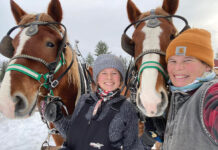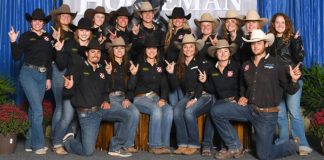Jillian Pace, M.S., and owner of Exercise Prescription & Pilates in Boerne, Texas, knows first-hand the unique muscles equestrians use to ride, whether for jumping or running barrels. As a competitor, Pace participated in Palomino and Quarter Horse all-around competitions, and now shows with the American Miniature Horse Association. She says that fit equestrians are investing in their partnership with their horse.
“For any sport, your body needs to be conditioned for optimal fitness,” says Pace. “Your horse is your partner. If you think about an ice skating duo, if only one partner is conditioned, the pair is not going to do very well together. The relationship between horse and rider is no different.”
A Targeted Workout
As an exercise trainer and nutrition expert, Pace develops exercises and programs tailored to her clients. For equestrians, Pace knows that developing strong inner thigh and hip flexor muscles is what helps create a balanced seat.
But she also focuses on other areas like the neck, shoulders, wrists and core. Here, she demonstrates four exercises that can be done anywhere and anytime, to strengthen riders for equestrian sport.
Before you start a workout, be sure to warm up. Even doing a simple, brisk five to 10-minute walk or jog gets the muscles ready to work.
1. PLIÉ-SQUAT
How it helps: This will strengthen legs to maintain proper leg and seat position, and also prevent floppy knees in the saddle.
Target muscles: Inner thighs, glutes
Reps: 10-20
Stand with your legs wider than hip distance apart, feet pointed to the side at approximately 45 degrees. Note that your leg turnout should come from your hips and not just your feet.
Engage your abdominal muscles and tuck your hips under you to create a neutral spine. Roll your shoulders back and set your shoulder blades. Pretend you have a string attached to your head pulling you straight up to help you maintain your posture.
Now inhale as you bend your knees to lower your body straight down into your plié. Keep slightly more weight in your heels, and avoid letting your knees extend over and past your toes. Only lower down as far as you can maintain proper form and posture. Exhale as you begin to straighten your knees back to your starting position. Focus on squeezing your inner thighs and glutes as you lift up from your plié.
2. HUNDRED
How it helps: Protects the back and reduces shoulder stress while improving posture in the saddle.
Target muscles: Abdominals, shoulders
Reps: 100 reps, or 10 sets of 10
There are two ways to perform the exercise: full method or modified. For both, begin by lying on your back with your knees in a table top position (90 degree bends at your hips and knees). Arms are extended long by your sides; allow your neck and shoulder to relax, preventing your shoulders from scrunching up toward your ears. Your abdominals should be engaged.
When performing this exercise, be sure to maintain shoulder straightness and do not hunch forward. Also, pretend there is a peach under your chin and do not jam your chin in to your chest.
FULL: Inhale to prepare. On the exhale, curl your neck and shoulders off of the mat like you are completing a crunch until just the tip of your shoulder blades are touching the mat. Avoid lifting up too far and creating a “popping” effect in your abdominal region. At the same time, extend your legs long to 45 degrees. Legs should be straight with feet parallel and pointed. Lift your arms just a few inches off of the mat.
Maintain this position for the entire exercise. Begin quickly pulsing your straight arms up and down while inhaling for 5 counts followed by exhaling for 5 counts. That is one set of 10. Repeat this sequence for up to 10 sets.
MODIFIED: This method eases stress in the lumbar-pelvic region until abdominals become stronger. Perform this exercise with your feet on the mat with a slight bend in your knee or with your feet in the tabletop position.
3. ALL IN ONE
How it helps: Spinal mobility and stretching the hamstrings, plus strengthening all muscle groups.
Target muscles: Shoulders, core abdominals, glutes and legs
Reps: 5-10
Stand nice and tall, facing forward with feet shoulder-distance apart. Inhale to prepare, and when you exhale, start from your head and bend down to the ground. This will feel like you’re rolling your spine all the way down, one vertebrae at a time, until you are touching the ground.
Walk your hands out in front of you, taking your body to a plank position. Hands are slightly wider than shoulder-width apart. Avoid reaching your arms too far in front of you. Your hands and wrists should be in a straight line. Stabilize your shoulders, and keep your neck aligned with your spine. Only toes and hands should be touching the ground.
Now you can opt to perform a push-up. Gently lower your knees to the ground and perform the push up from your knees, or simply inhale and walk your hands back toward your body. As you roll back up, you will stretch your muscles, and the roll will feel like the reverse of the roll down.
To add difficulty, do half of the reps with one leg raised, and the other half raising the opposite leg. Just be sure to keep your neck straight and maintain spinal alignment.
4. KNEELING HIP FLEXOR STRETCH
How it helps: Elongates the muscles that are most often kept in a rigid position when riding.
Target muscles: Legs, glutes, back and more
Reps: 2-3 times each side, holding the stretch for approximately 30 seconds
Begin in a kneeling position. Bring one leg forward and bend your knee, creating a 90-degree angle at the hip and knee. The back supporting knee will also have some bend, with the top of the foot flat on the mat. Forgetting to tuck your glutes and arching your back leads to strain in the lower back and lack of stretch in the hip flexor.
Allow your hand to rest on your front thigh or on your hips. Engage your abdominals, tuck your hips under, and shift your weight forward into the stretch. Hips should be facing straight forward. Avoid opening up one hip to the side.
Don’t forget to breathe! After holding, release back to your starting position, then repeat.
Working your muscles even when not riding will have a positive effect on life in and out of the saddle. But Pace says that the best way to achieve a fit rider goal is to first set one. Then, work toward that goal.
“When you start an exercise program with a purpose, you are more likely to stick with it,” she says. “You’ll become who you want to be. Whether that is a better rider or done to gain muscle, you can look at exercise as medicine. It needs to be a requirement not just for health, but as an underlying foundation for all elite athletes.”
Benefits of Being Fit to Ride
In addition to building a better partnership with your horse, Pace points out the additional benefits of being a fit rider.
Better Posture & Balance
You’ll have better posture, flexibility, mobility, balance and coordination when you routinely work your muscle groups. This translates to a more relaxed and balanced position in the saddle because you aren’t having to work so hard.
Competitive Advantage
“When the body is conditioned, you have time to work on the fine details,” says Pace. “I think of it like this: You can’t focus on fixing your horse’s head, neck and shoulders in the reining circle if the horse doesn’t have the stamina to perform large, fast circles. Your body is no different.”
Enjoying the Ride
Pace points out that out-of-shape riders often suffer from aches and pains that diminish the overall quality of their riding experience. That comes from muscles that develop incorrectly. Over time, the body starts to compensate for a lack of fitness by using the wrong muscles. The more fit you are, the more fun you’ll have in the saddle.
Meet the Fitness Expert
Jillian Pace put a lot of stress on her body as a competitive rider and dancer. Injuries fueled her desire to understand how to better train her body to perform. After receiving a Master of Science in kinesiology and exercise science from the University of Texas-San Antonio, Pace opened her own studio. The medical exercise specialist and clinical pilates practitioner now helps others achieve their dreams.






